39: Mixed Packs
A number of mixed packs appear for sale from time to time, but it's important to sort out what is meant by the term mixed. It is an issue that is not as straightforward as it might seem.
A number of mixed packs appear for sale from time to time, but it's important to sort out what is meant by the term mixed. It is an issue that is not as straightforward as it might seem. First of all we should distinguish between what might be termed in-house mixing, where a maker has published a pack with cards of different styles (a consistent back design would be a clue in such cases) and those cases where some outside hand has interfered in some way with the make-up of the pack, usually for illegitimate purposes. Cards with no back design help the perpetrator with the latter kind of mixing.
Let's start with two examples of the former kind of mixing. When a maker had more than one style of court card or pip shape, it was always possible that packs put together by hand, as was normal up into the 1870s, could end up with different styles in one pack. Hardy produced an unusual design of court card in the 1830s (see page 32), but there's a pack with the QS & JS of his normal Type III courts.

Above: Hardy, c.1830
Later, when there are consistent back designs to help us, we find different types of pip design in Goodall's packs.

Below: Similarly with De La Rue's packs, where different styles of court card appear in the same pack:


Above: De La Rue D5 queens (unturned) and D6 kings and jacks (turned), c.1875
And much later, in the 1940s, Waddington issued a pack with mixed W5.1 and W5.5 courts with a redrawn QD. I have no idea how this would come about with mechanical sorting!

Above: Waddington W5.1 KH, W5.5 QC and QD with redrawn face, c.1947
Personally, I love this kind of oddity!
There is another in-house kind of mixing that is found in wood-block cards. It was customary in the late 18th and early 19th centuries to produce ten courts on one block and the two red jacks (x 5) on another, which meant that in some packs the red jacks don't match the other courts, if a maker used more than one type of court. There are a number of examples on other pages of my blog: the Creswick packs on page 32 and the first Hall pack on page 31 (Type II with Type I red jacks). This practice finished with the modernizing makers such as De La Rue and Goodall, who printed all the courts together.
The other kind of mixing, by outside interference, is more difficult to determine, though there are some clues. Some packs have been mixed up from use, careless handling (such as putting together different packs without regard to the backs or even front design when re-sorting two or more packs) and recent attempts to make up complete packs, sometimes even for purposes of deception. The clue here is either an obvious mismatch of makers, e.g. Goodall & Bancks cards in the same pack, or uneven wear throughout the pack, i.e. varying degrees of cleanness. On the other hand, there are two other possibilities: second-hand packs and packs released illegally. The first of these was regulated by taxation rules and such packs were supposed to be tax-wrapped and marked as second-hand. (See page 13 for a late 19th century example of imported second-hand cards from America.) It is fairly certain that dealers in second-hand cards did not always abide by the legal requirements. In the days of plain backs, packs this kind were typically made up of cards by different makers, but the wear is consistent, which tells us that the mixing happened a long time ago. Such a pack was offered on eBay a while ago: it had a James Hardy Exportation Garter AS with four genuine Hardy courts, four Type I Hunt courts and four Hunt HB1 courts. The number cards were not consistent, either, but the wear was. This suggests that it was a made-up, second-hand pack of the 1820s (the earliest date for the introduction of HB1 courts). It is likely to be an illegal pack, as Exportation ASs were not to be used for the home market. Other packs, which are consistent except for the AS, are also likely to have been illegally sold in this country, especially if the ace is an export one. The packs below share a lot of their court cards (i.e. they are from the same blocks), which are typical of those made by Hall. Indeed, the bottom pack has a Hall Garter AS, but the top one has a Hunt & Son, successors to Gibson, Exportation ace and the middle one a Wheeler's Ludlow ace. However, I should point out that I have more recently acquired a Hunt pack with Type II courts, which are clearly original.

There must have been some kind of illegal trade in duty aces, whether they were sold to others without permission as waste-paper or as bankrupt stock. Hart duty aces, for example, appear in all kinds of packs: the following one has Hall courts and the lower one looks American in style. The aces are genuine, the packs are illegal.

Above: From Plainbacks, A2
 Above: From Plainbacks, A28
Above: From Plainbacks, A28
Plainbacks A16 also looks American and may have a forged AS. Note that none of the packs I have discussed above should be termed fakes or forgeries: they have been put together from perfectly genuine cards, even if they were sometimes sold illegally. Forgery is something different. In this case either the AS is forged to avoid paying the tax, as in the case of Harding, or the whole pack is made by someone else and purports to be by a legitimate maker, as in the case of the Belgian fake illustrated on page 18, again with the intention of defrauding the taxman.
There's a really intriguing pack that was sold in 2015 in the United States with a Nathaniel Ford AS and court cards that are almost certainly from Hunt's blocks. The date given was c.1820.

Above: Type I courts as made by Hunt with a Nathaniel Ford AS, c.1820
A possible explanation - but one that is only supposition - is that because Hunt redesigned his courts in c.1820 (HB1 - see page 30), he might well have sold off his old blocks to the American maker. Just a thought!
What to do when offered a mixed pack? That's up to the purchaser. If one wants an example of an evenly worn, second-hand pack of the early 19th century, then look for the signs that what you are being offered is such a pack. If you're offered a mixture of clean and dirty cards, even by what appears to be the same maker, take extra care in making your decision.
Here are two more examples of mixed packs, which give an idea of what to look out for.
 Above: This is pack B21 from plainbacks. The QS is not by Wheeler, but by Hardy. There are good reasons for claiming this, though there is no room here to go into the details, but both the cut of the block and the colour distribution are those of Hardy. For example, the blue under the sceptre is typical of Hardy, whereas Wheeler does not use this colour here, and Wheeler colours the arm blue and red, rather than all blue. On the other hand, the red jacks are by Wheeler, even though they have a different eye type (II rather than I, as on the other courts). This is an example of the in-house mixing that I referred to above, and is found in other Wheeler packs.
Above: This is pack B21 from plainbacks. The QS is not by Wheeler, but by Hardy. There are good reasons for claiming this, though there is no room here to go into the details, but both the cut of the block and the colour distribution are those of Hardy. For example, the blue under the sceptre is typical of Hardy, whereas Wheeler does not use this colour here, and Wheeler colours the arm blue and red, rather than all blue. On the other hand, the red jacks are by Wheeler, even though they have a different eye type (II rather than I, as on the other courts). This is an example of the in-house mixing that I referred to above, and is found in other Wheeler packs.
 Above: These courts are from F25 on Plainbacks, a pack with an Old Frizzle AS by Creswick. All the courts are by Creswick except for the KD: this is from a Hunt HB1 pack. It is difficult to tell from a scan, but the paper looks lighter than on the other courts.
Above: These courts are from F25 on Plainbacks, a pack with an Old Frizzle AS by Creswick. All the courts are by Creswick except for the KD: this is from a Hunt HB1 pack. It is difficult to tell from a scan, but the paper looks lighter than on the other courts.
A couple of further examples give more evidence of the kind of mixing that one can find. The first is a Hunt pack of c.1813-15 which has at least three cards that are in some way unexpected. The 2S & 3S have a pip shape that is different from the other spades (see the 4S); they are found in later packs by Hunt with HB1 courts, but still a Garter AS. The other odd card, the KD, is much more difficult to explain, as it's by Hall (with Type II eyes, rather than Hunt's Type I), of about the same date. The reason these cards can't be just labelled 'secondhand' is that all the cards have gold edges. Since this must have been a relatively expensive process, it's unlikely to have been applied to second-hand cards, which were usually sold for just a few pence (but see below regarding the Hardy mixed pack near the bottom of the page). So, how does a Hall KD get into a Hunt pack? Well, they were close neighbours in Piccadilly at this time, and later, in 1840, amalgamated. So it could be that they helped each other out sometimes with stocks of cards that were low or had run out, but I expect we'll never know the exact details of their relationship before the amalgamation.
 Above: Hunt, c.1810, gold edges
Above: Hunt, c.1810, gold edges
The second pack is much more recent, from the early days of the canasta boom in the early 1950s. Auto Novelties Ltd produced a number of cheap boxed sets, including an autobridge board. The tradename was Barden. In this canasta set the two Goodall packs are different from one another. This can be seen most clearly in the jokers. The number cards of the lower pack are those of contemporary Waddington packs (don't forget, from the early 1940s Waddington was printing all the cards for De La Rue and their subsidiary), whereas those of the top one are of the De La Rue style. There is even a small difference in the KCs: the top one has a white strip next to his sword, whereas the bottom one has black. Even the ASs are different: the top one is an unusual revival of the & Son style (pre-1897), whereas the bottom one is a crude printing of De La Rue's version. When I got the set, the packs were mixed up, despite the fact that the backs are of a slightly different shade of dark blue. So there's evidence of another way packs can get mixed, just by use. It was carelessness during the making-up of the set that caused this example.


Above: Barden canasta set, c.1952
For corroborative evidence of what went on in the sale of playing cards in the 19th century read the fascinating account from Henry Mayhew's London labour and the London poor, first issued (serially) in the 1840s, but re-issued in 1851 in three volumes: view here. The drop-down text is about halfway down the page.
A really odd mix-up
A while ago I acquired a really odd example of mixing two packs together.


As you can see, there are both single-figure (D2) and double-ended courts (D4) in this De La Rue pack. The wear is consistent with use over a long period and all the backs match (there are 46 of 52 cards). All the pip cards are consistent in style and shape. There is an accompanying card (illustrated) on which is written in a 20th century hand "Found in a Grace and Favour apartment", but also the following in a Victorian hand: "Pack of cards used by Queen Victoria, Prince Consort, Napoleon III and Empress Eugenie." Clearly the cards were mixed up from two packs a long time ago. The double-ended pack is from c.1855; it has the first version of the double-ended designs. If the claim on the accompanying card is true, it indicates that they were, indeed, played with in 1855, when the French royal couple visited England. A later date is very unlikely. Even though after Napoleon III was deposed as Emperor of France, he retired to England and lived in Kent from 1870-73, where he died after three years, Prince Albert was dead by then and Napoleon was ill. So, it looks as though the double-ended pack was used in 1855, but was later mixed up with an earlier pack and at some time given to a retired servant/lady-in-waiting, no doubt after they'd been well used! It's certainly very unlikely that Queen Victoria played with them in that condition! Of course, we'll never know what happened to them, but it can be fun to speculate, if we have some facts to go on. What it does show, however, is that packs with this back, claimed to have been produced for Victoria and Albert's wedding in 1840, were produced over a lengthy period from 1840 probably until 1861, when Albert died.
An even odder mixed pack
Another acquisition is even more bizarre. The pack has an I (James) Hardy AS of c.1801-10, nine courts are genuine but three are not. The cards have all been shaved on all sides and the 2s to 6s are unused. The latter have gold edges and there are very slight traces of gold on a few of the worn cards over 6.

Above: The top three courts are genuine Hardy ones, the next three are not: the JD is definitely by Reynolds (I have a Reynolds pack with the same JD) and the QD & JC could well be by Reynolds, too. Note how the cropping of the cards has caught the top of the 6S & 2H. But the number cards are not consistent either and even the clean 2s-6s are not all consistently by Hardy. The pip shapes are different in three of the suits, as shown below.

The 7-10S are all by Hunt from the 1820s and would normally accompany HB1 courts, that is the redrawn, in-house design; they are quite a different shape from the 2s-6s, as exemplified by the 3S. The Hardy clubs have a relatively slender stalk, whereas the AC, 7C & 8C have the shorter, fatter ones of Reynolds or earlier Hunt. The Hardy hearts are more rounded towards the bottom tip, as on the 4H, whereas they are straighter on the 3H, 6H, 8H & 9H, so in this case even the low hearts are inconsistent as regards maker.
So what are we to make of this? The cards are mixed, which suggests a secondhand mixture. The worn cards show consistent wear, so they are unlikely to have been put together later in their existence. The cards have been shaved, which is normal for gold-edged cards of this period. I have a Wheeler exportation pack of about the same dimensions, which still has its gold edges. But why would anyone go to the trouble of gilding a secondhand pack? Maybe there was a market for slightly more expensive secondhand cards; we know that Mudie was selling such cards around 1820 as a legitimate business. Again, we'll never know, but going through the possibilities is always fun!
Yet another brain-teaser
In May 2019 I acquired a most peculiar pack , which I suspected was a mixed one. However, on close inspection it seems to be perfectly consistent. The odd thing is that it appears to have Creswick courts (CR1) with a Hall & Bancks AS. Since the backs are a consistent pale blue, it is unlikely to have been put together as a secondhand pack. Furthermore, whereas the red jacks in Creswick packs are Type III or Type II with goggle eyes like those of Stone, this pack has Type II red jacks like those of Hall. And the QS, for instance, has colouring consistent with Hall cards, not like those by Creswick; the sleeve colouring under the QH's hand on the left is likewise consistent with Hall QHs.

So this pack throws up a whole list of unanswered questions. There is no known link between Hall & Bancks and Creswick, unless the former firm bought up some old stock when the latter's firm was wound up in 1843. Who knows?!
And finally, a word of warning!
There are a lot of American packs with all-over back designs often made up of six-pointed stars. I recently acquired such a pack which had been mixed up extremely carelessly. I was aware of this, so am not complaining in any way, but I thought it might help people to see how inconsistent packs can be made up. The pack was basically a pack of 43 cards made by the Eagle Card Co in c.1867. It had an original joker.

Courts very similar to those used by Lawrence & Cohen and Hart (both part of NYCC).
The rest of the cards were a hotch-potch of oddments, even containing two 8Hs and no AH. The KS is by Levy and the QS is from a Dougherty faro pack. The backs didn't match properly - in two cases the straight star points were horizontal, not vertical - the size of the cards varied considerably, and the pips were very different.


Various pip types; the two bottom right are the genuine Eagle ones.
I knew what the pack was like before I bought it and no attempt had been made to hide the irregular make-up. But do be careful, as some sellers are not so assiduous.
On the other hand, at a recent Stroud auction the following pack appeared purporting to be a complete Hall pack. The courts and AS are by Hall, but the number cards don't match in pip style, size or colour of board; all the number cards are slightly wider that the courts. This can happen when a collector separates the courts from the rest of the pack (for display, etc.) and puts them back together wrongly, mixing up at least two packs in this way. It may be even more difficult when a collector dies and those left to dispose of the collection have no idea how to match up courts and number cards. Auction houses don't have enough expertise, time or desire to check such things. What is worse, they are often unwilling to acknowledge the situation and make appropriate amends.

Although by Hall, even the KC has a different style from the other courts and is on darker board; note how the 7C has been poorly stencilled on the right.
On the other hand, a recent eBay offering clearly stated it was a mixed pack and was clearly something to look at in detail. Basically, it's a mix of Blanchard cards (all the black ones) and Gibson cards (all the red ones) with an AS made from an overprinted AH. Clearly a tax dodge, but a very odd one, as the two sets of cards are of different heights, as can be seen in the scan below. It's in excellent condition, so probably never played with. Gibson took over Blanchard's firm in 1770, so it would seem to have been an in-house effort made up of spares and old stock. A fun curiosity and one which was clearly sold as such.




By Ken Lodge
Member since May 14, 2012
I'm Ken Lodge and have been collecting playing cards since I was about eighteen months old (1945). I am also a trained academic, so I can observe and analyze reasonably well. I've applied these analytical techniques over a long period of time to the study of playing cards and have managed to assemble a large amount of information about them, especially those of the standard English pattern. About Ken Lodge →
Trending Articles
Popular articles from the past 28 days
Related Articles
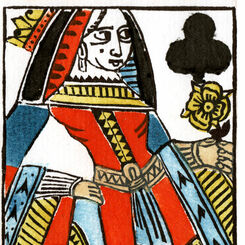
Woodblock and Stencil Queen of Clubs
A limited edition art print of the Queen of Clubs 1984 woodblock joker.
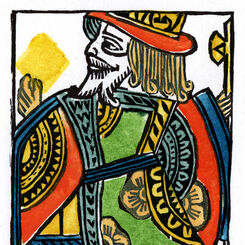
Woodblock and Stencil King of Diamonds
A limited edition art print of the King of Diamonds 1984 woodblock joker.
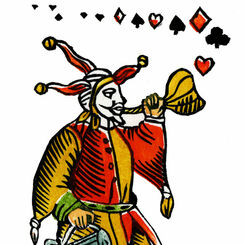
Woodblock and Stencil Joker
A limited edition art print of the 1984 woodblock joker.
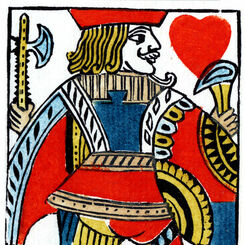
Woodblock and Stencil Jack of Hearts
A limited edition art print of the Jack of Hearts 1984 woodblock joker.
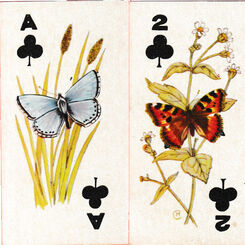
Sweetule Natural History cards
Small cards featuring natural history subjects, given away with packets of sweet cigarettes.
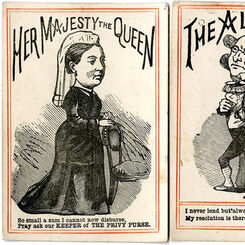
Lend Me Five Shillings
or “Her Majesty’s Privy Purse” - a merry round-the-table game published by D. Ogilvy.
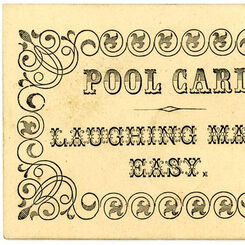
Laughing Made Easy
a Victorian card game published by D. Ogilvy.
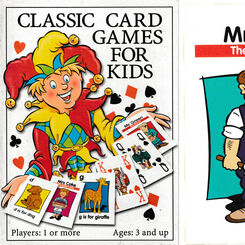
Classic Card Games for Kids
A boxed set of playing cards, Happy Families and an alphabet pack with rules for 22 games.
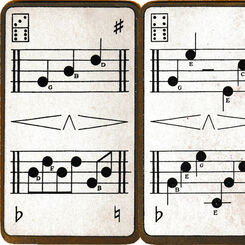
So-Lah – A Game of Music
An early 20th century domino-type musical card game by Goodall.
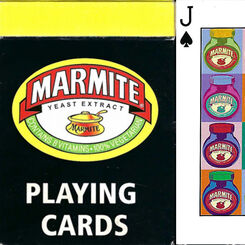
Marmite
Fifty-Four images celebrating a UK savoury spread, that has been around one hundred and twenty two y...
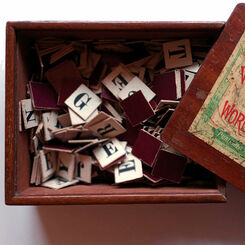
Word Making and Word Taking
How crossword and spelling games became popular.
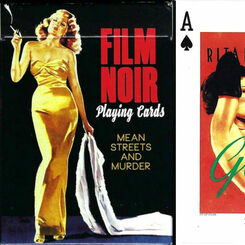
Film Noir
A deck of 55 cards, celebrating hard boiled heroes, wise-cracking women, mean streets, guns and gums...
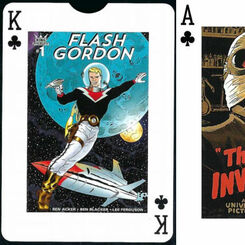
Science Fiction
A deck of 55 cards, celebrating a time when Science Fiction truly was, Science Fiction.
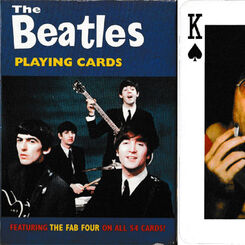
The Beatles playing cards
Two packs featuring photos of The Beatles issued by the same publisher in 2004 and 2005.
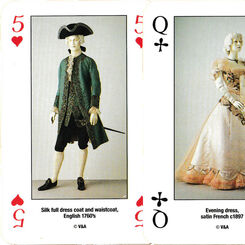
Costume Playing Cards
Four centuries of costumes from the Costume Court at the Victoria and Albert Museum.
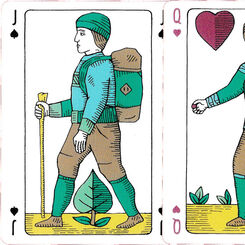
Commoners playing cards
Created by Ian Cumpstey dedicated to the common land and the countryside.
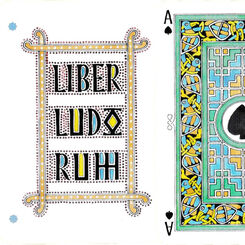
Liber Ludorum
Liber Ludorum playing cards created by Ian Cumpstey in the insular style, United Kingdom, 2019.
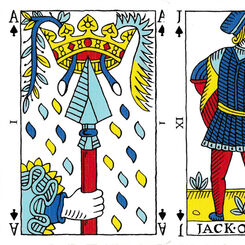
Pike and Clover playing cards
Pike and Clover playing cards created by Ian Cumpstey, Cumbria, UK, 2018.
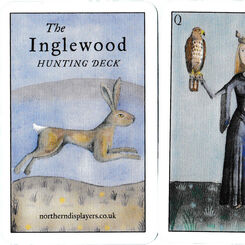
Inglewood Hunting Deck
Inglewood Hunting Deck created by Ian Cumpstey, United Kingdom, 2023.
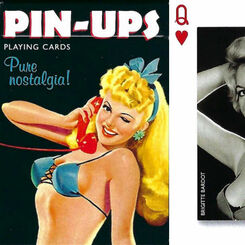
Pin-Ups
A deck of 55 cards celebrating a golden age of cheeky, naughty, bold and curvy ladies in film.
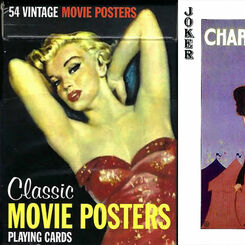
Classic Movie Posters
A deck of 55 cards presenting vintage classic movies and their stars.
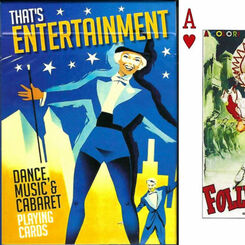
That’s Entertainment
A deck of 55 cards celebrating 20th Century vaudeville, musicals and cabaret.
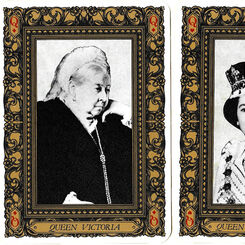
British Monarchs
Commemorating the royal wedding of Charles, Prince of Wales to Lady Diana Spencer on the 29th
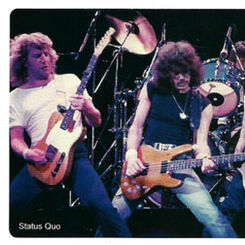
Rock & Pop Legends
Stunning photos of a selection of US and UK music artists.
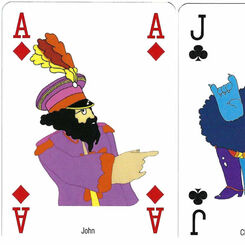
The Beatles • Yellow Submarine
A colourful deck celebrating the 1968 animated feature film based on the Lennon/McCartney song of th...
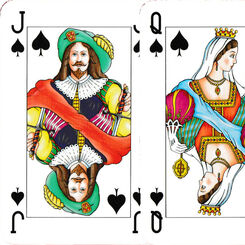
Dutch Court playing cards
Games & Print Services’ version of the Dutch pattern.
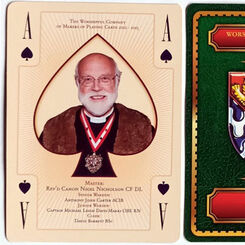
Past Masters’ Association Presentation Pack
The Worshipful Company of Makers of Playing Cards Past Masters’ Association Presentation Pack, 2013....
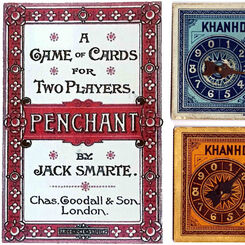
The Search for New Games in the late 19th century
A few new games survived and are still around today; most came and went and are only witnessed in th...
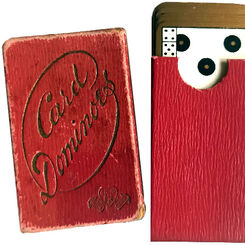
Miniature Card Dominoes
A miniature set of Goodall domino cards (5.9 x 3.5 cms) still in perfect condition.
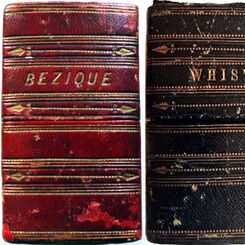
T. Drayton & Son
Bezique and Whist boxed sets by T. Drayton & Son, London, c.1875.
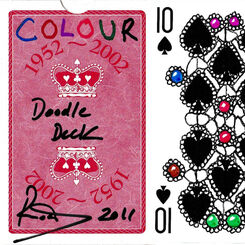
Colour doodle deck
“1952-2002 commemorative deck” customised with doodles by an uncredited artist, UK, 2011.
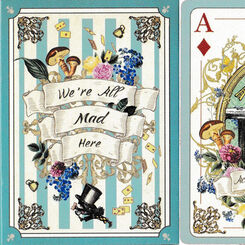
Alice in Wonderland: we’re all mad here
Alice in Wonderland themed playing cards, UK, 2020.
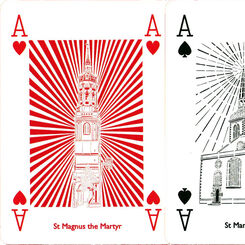
Wren 300 playing cards
Papercuts by Chloe Campbell of the 52 Wren churches in the City of London.
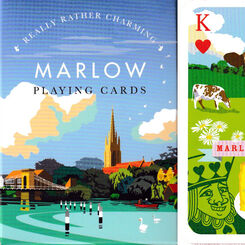
Marlow playing cards
Visitor attractions and businesses to be found in Marlow, Buckinghamshire.
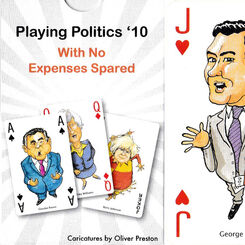
Playing Politics 2010
“Playing Politics ’10: With no expenses spared” featuring caricatures by Oliver Preston, published b...
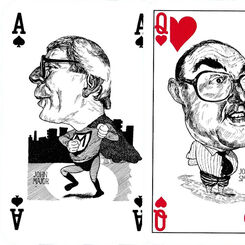
Playing Politics ’92: Pack of lies
Playing Politics ’92: Pack of lies with caricatures by Grant Robertson, UK.
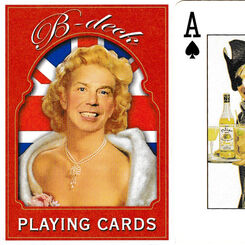
B-Deck
“B-Deck” scurrilous playing cards poking fun at a former UK prime minister.
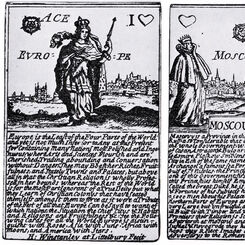
Winstanley Geographical cards
Facsimile of Winstanley’s Geographical cards produced by Harold & Virginia Wayland, 1967.
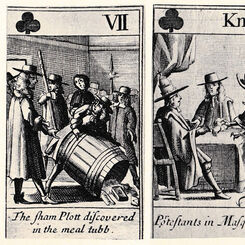
Meal Tub Plot
Meal Tub Plot playing cards [facsimile] with 17th century sketches by Francis Barlow.
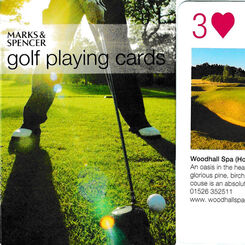
Golf playing cards
Golf playing cards published by Marks & Spencer, UK.
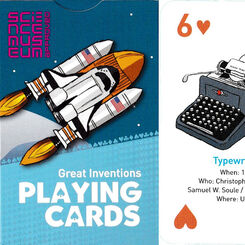
Great inventions playing cards
Great inventions playing cards designed by Gary Wyatt, United Kingdom, 2011.
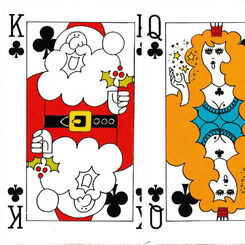
Christmas 1980 playing cards
Festive courts on a Waddingtons pack designed to celebrate Christmas 1980.
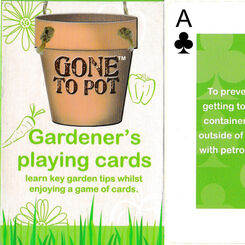
Gone to Pot: Gardener’s playing cards
‘Gone to Pot’: special playing cards for keen gardeners, United Kingdom.
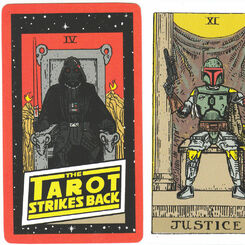
The Tarot Strikes Back
Roy Huteson Stewart's The Tarot Strikes Back combines Star Wars with Rider-Waite tarot imagery.


